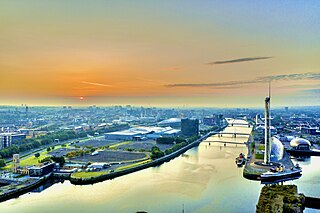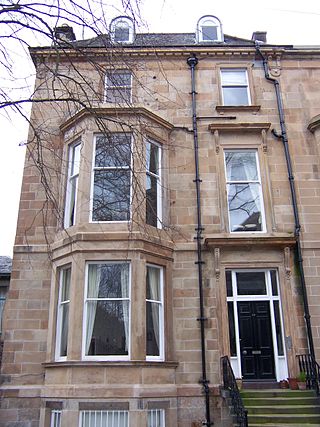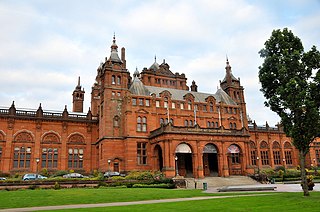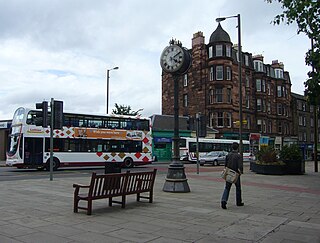
Glasgow is the most populous city in Scotland, located on the banks of the River Clyde in west central Scotland. The city is the third-most populous city in the United Kingdom and the 27th-most populous city in Europe. In 2022, it had an estimated population as a defined locality of 632,350 and anchored an urban settlement of 1,028,220. The economy of Glasgow is the largest of any city or region in Scotland's economy, and the cities economic strength is reflected in its membership of the Core Cities Group.

Sir Basil Urwin Spence, was a Scottish architect, most notably associated with Coventry Cathedral in England and the Beehive in New Zealand, but also responsible for numerous other buildings in the Modernist/Brutalist style.

The Hunterian is a complex of museums located in and operated by the University of Glasgow in Glasgow, Scotland. It is the oldest museum in Scotland. It covers the Hunterian Museum, the Hunterian Art Gallery, the Mackintosh House, the Zoology Museum and the Anatomy Museum, which are all located in various buildings on the main campus of the university in the west end of Glasgow.

Pollokshields is an area in the Southside of Glasgow, Scotland. Its modern boundaries are largely man-made, being formed by the M77 motorway to the west and northwest with the open land of Pollok Country Park and the Dumbreck neighbourhood beyond, by the Inverclyde Line railway and other branches which separate its territory from the largely industrial areas of Kinning Park, Kingston and Port Eglinton, and by the Glasgow South Western Line running from the east to south, bordering Govanhill, Strathbungo, Crossmyloof and Shawlands residential areas. There is also a suburban railway running through the area.

Port Sunlight is a model village in the Metropolitan Borough of Wirral, Merseyside, England. It is located between Lower Bebington and New Ferry, on the Wirral Peninsula. Port Sunlight was built by Lever Brothers to accommodate workers in its soap factory ; work commenced in 1888. The name is derived from Lever Brothers' most popular brand of cleaning agent, Sunlight.

Hyndland is an affluent residential area in the West End of the city of Glasgow, Scotland.

Kelvingrove Art Gallery and Museum is a museum and art gallery in Glasgow, Scotland, managed by Glasgow Museums. The building is located in Kelvingrove Park in the West End of the city, adjacent to Argyle Street. Kelvingrove Art Gallery and Museum is one of Scotland's most popular museums and free visitor attractions.

The Burrell Collection is a museum in Glasgow, Scotland, managed by Glasgow Museums. It houses the art collection of Sir William Burrell and Constance, Lady Burrell. The museum opened in 1983 and reopened on 29 March 2022 following a major refurbishment. It was announced as the winner of the Art Fund Museum of the Year in July 2023. It is the only non-national museum to be the outright winner twice.
Sir Robert Hogg Matthew, OBE FRIBA FRSE was a Scottish architect and a leading proponent of modernism.

Morningside is a district and former village in the south of Edinburgh, Scotland. It lies alongside the main arterial Morningside Road, part of an ancient route from Edinburgh to the south west of Scotland. The original village served several farms and estates in the area. In the 19th century, it developed as a residential suburb, its growth being stimulated by the arrival of a railway service and other transport improvements.

Easterhouse is a suburb of Glasgow, Scotland, 6 miles (10 km) east of the city centre on land gained from the county of Lanarkshire as part of an expansion of Glasgow before the Second World War. The area is on high ground north of the River Clyde and south of the River Kelvin and Campsie Fells.

Tower Gardens in North Tottenham is a distinctive semi-circular estate bounded by Lordship Lane and the Roundway. Constructed between 1904 and 1928, it was one of the first municipal "cottage estates" in the world. It is now a conservation area and is featured in the annual London Open City architecture weekend held third weekend in September. Originally known as the White Hart Lane Estate, Tower Gardens was built by the London County Council (LCC) using powers granted to local authorities by the Housing of the Working Classes Act 1900. Samuel Montagu, 1st Baron Swaythling donated £10,000 for the purchase of the land on which it was built. The donation was tied to the rehousing of Jewish workers resident in the Tower Hamlets parish, and required an area of land to be set aside for public gardens: hence the name Tower Gardens. Tower Gardens was also the first LCC estate to be built outside the LCC area.

Millennium Square is a city square in the Civic Quarter of Leeds, West Yorkshire, England. It was Leeds's flagship project to mark the year 2000, and was jointly funded by Leeds City Council and the Millennium Commission. Total cost of production was £12 million.
Silver End is a garden village in between Witham and Braintree, Essex, in England. It was conceived in the 1920s as a model village by the industrialist Francis Henry Crittall who established a Crittall Windows Ltd factory there to manufacture components for metal windows.

Bedford Park is a suburban development in Chiswick, London, begun in 1875 under the direction of Jonathan Carr, with many large houses in British Queen Anne Revival style by Norman Shaw and other leading Victorian era architects including Edward William Godwin, Edward John May, Henry Wilson, and Maurice Bingham Adams. Its architecture is characterised by red brick with an eclectic mixture of features, such as tile-hung walls, gables in varying shapes, balconies, bay windows, terracotta and rubbed brick decorations, pediments, elaborate chimneys, and balustrades painted white.

Gateacre is a suburb of Liverpool, England, located approximately 6 miles (9.7 km) south of the city centre. It is bordered by the suburbs of Belle Vale, Childwall, and Woolton. The area is noted for its Tudor Revival architecture and contains over 100 listed buildings within a quarter-mile of its centre, making it one of the most important historic areas in the city.

Walmer Crescent, situated in Cessnock, Glasgow, Scotland, consists of a curved row of spacious tenement flats and houses, designed by the architect Alexander Thomson and built between 1857 and 1862.

St. Peter's Seminary is a former Roman Catholic seminary near Cardross, Argyll and Bute, Scotland. Designed by the firm of Gillespie, Kidd & Coia, it has been described by the international architecture conservation organisation Docomomo International as a modern "building of world significance". It is one of only 42 post-war buildings in Scotland to be listed at Category A, the highest level of protection for a building of "special architectural or historic interest". It has been abandoned since 1987, and is currently in a ruined state. In July 2020, the site was given to the Kilmahew Education Trust Ltd who plan to reinstate the educational elements of the Seminary Complex after conservation and restoration.

BBC Pacific Quay is the headquarters of BBC Scotland, serving as its main television and radio studio complex, situated at Pacific Quay, Glasgow, Scotland.

Chapel Allerton is an inner suburb of north-east Leeds, West Yorkshire, England, 2 miles (3.2 km) from the city centre.




















